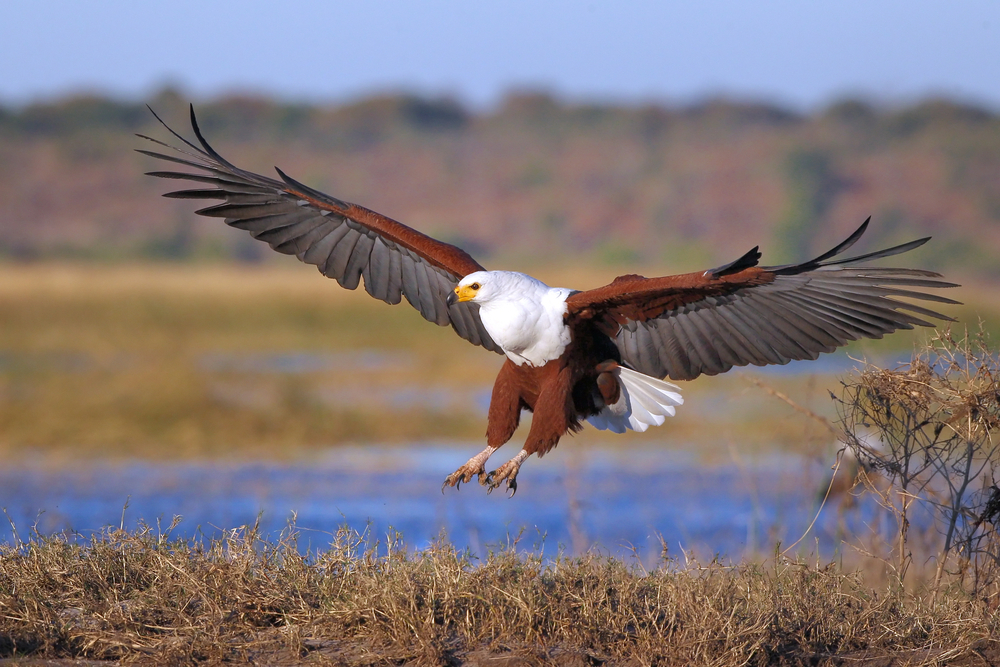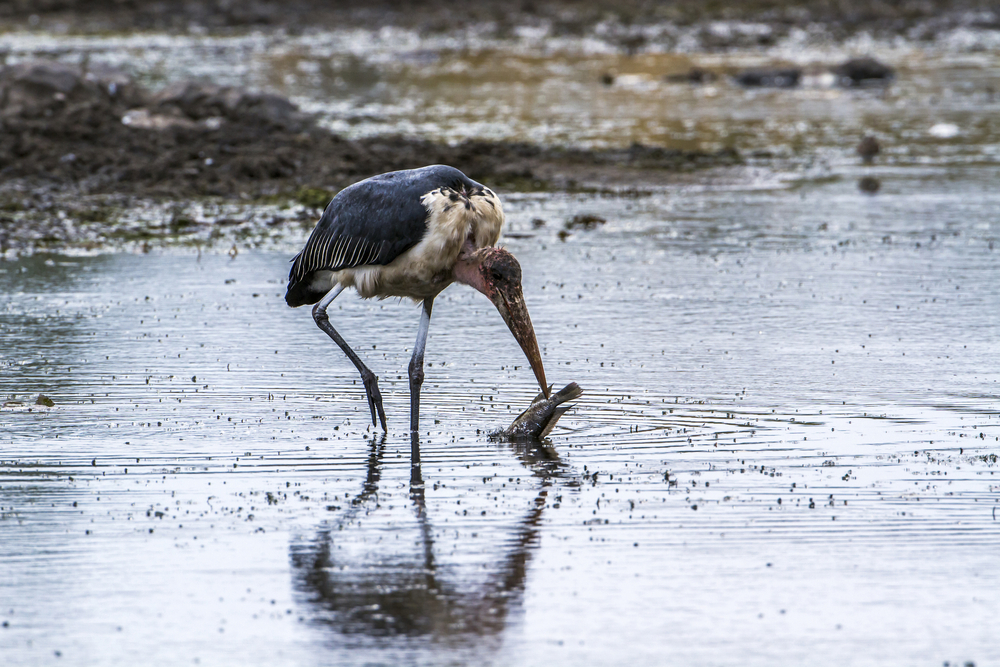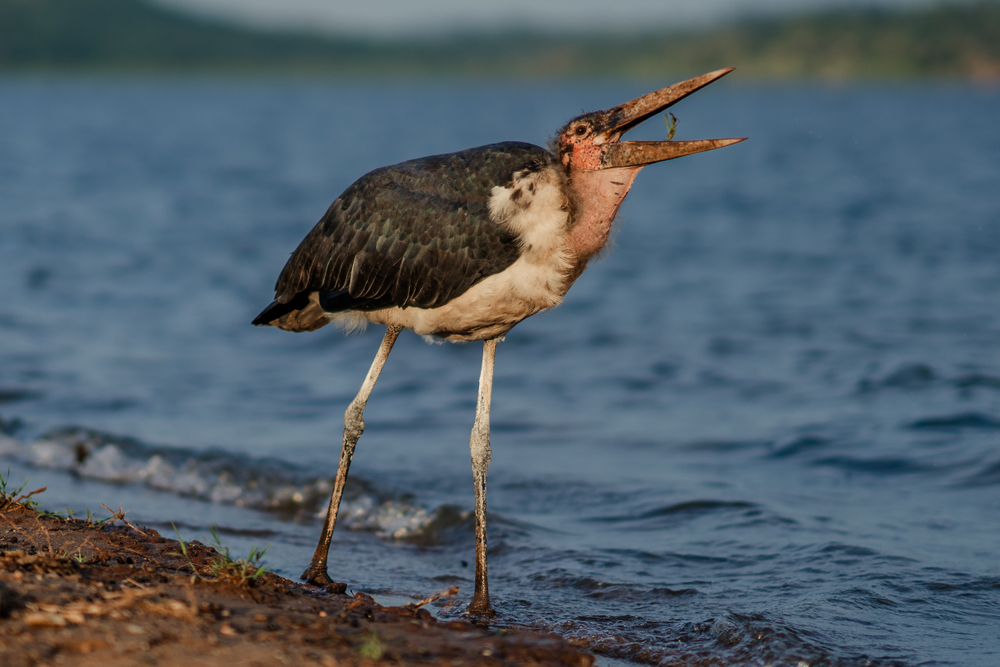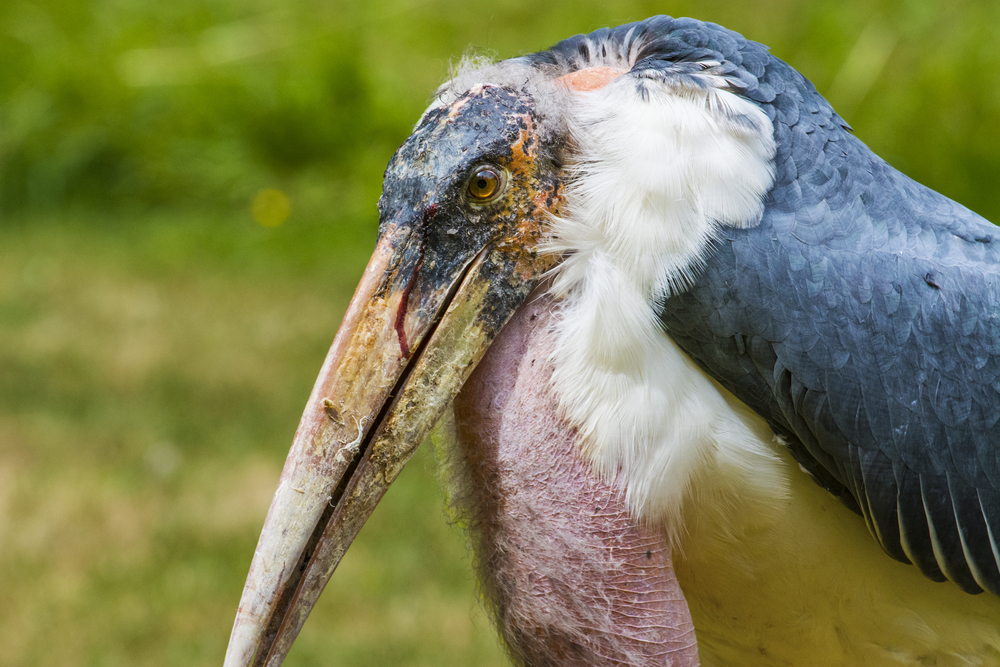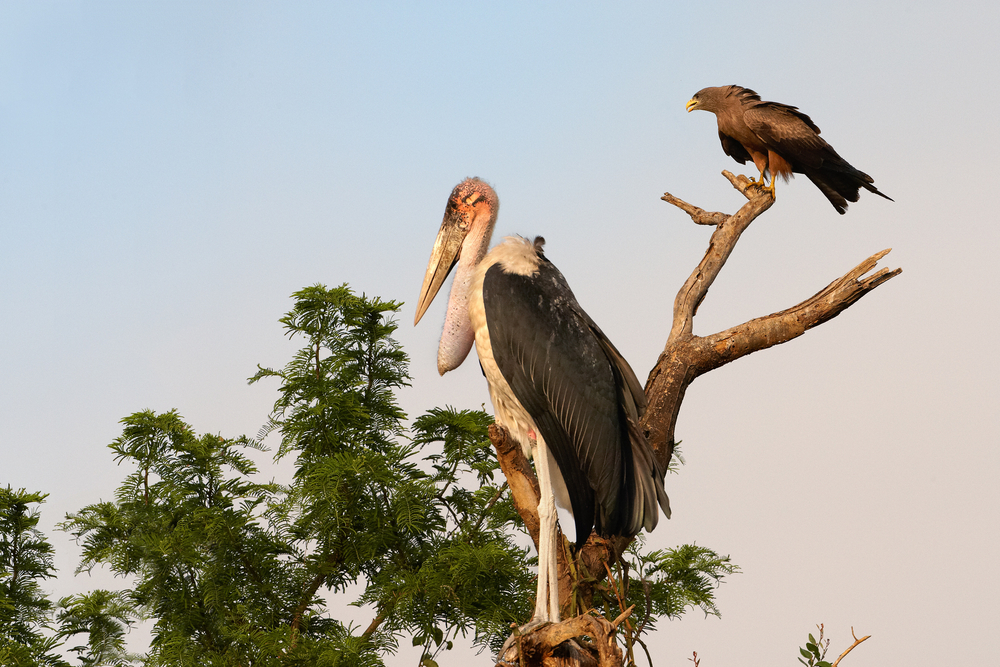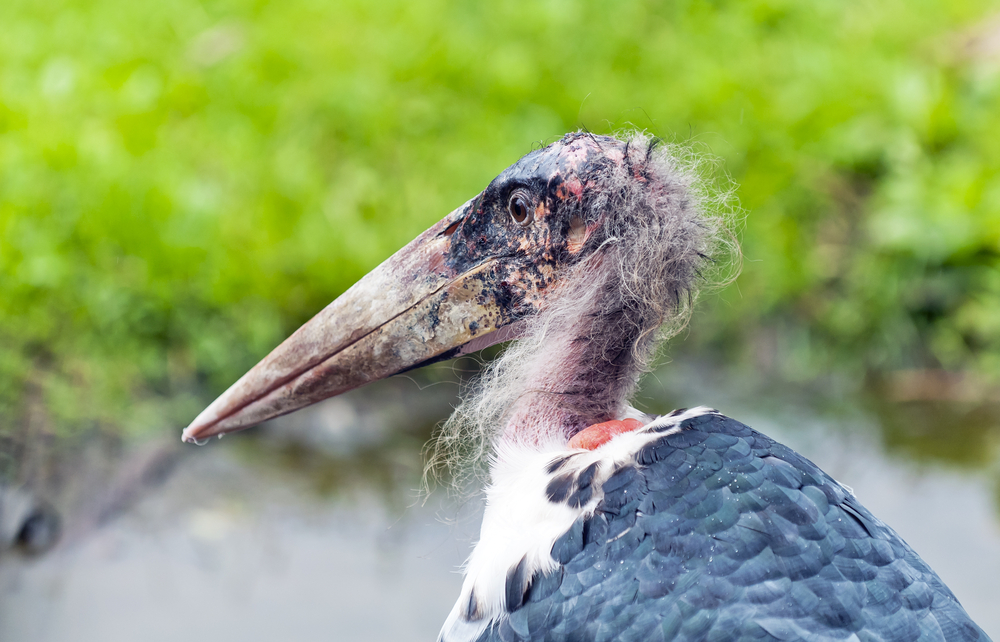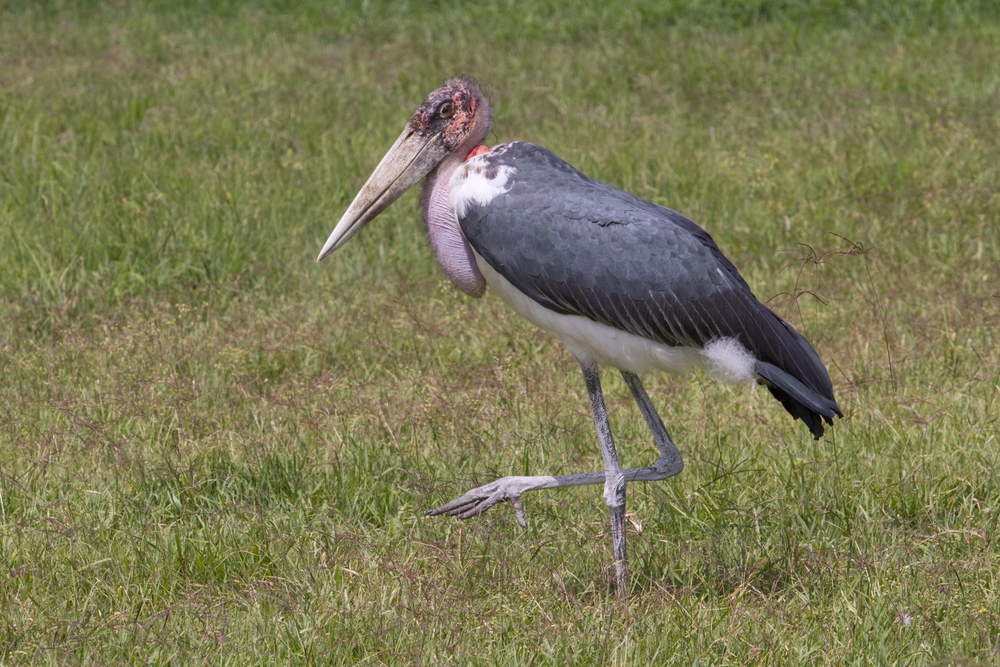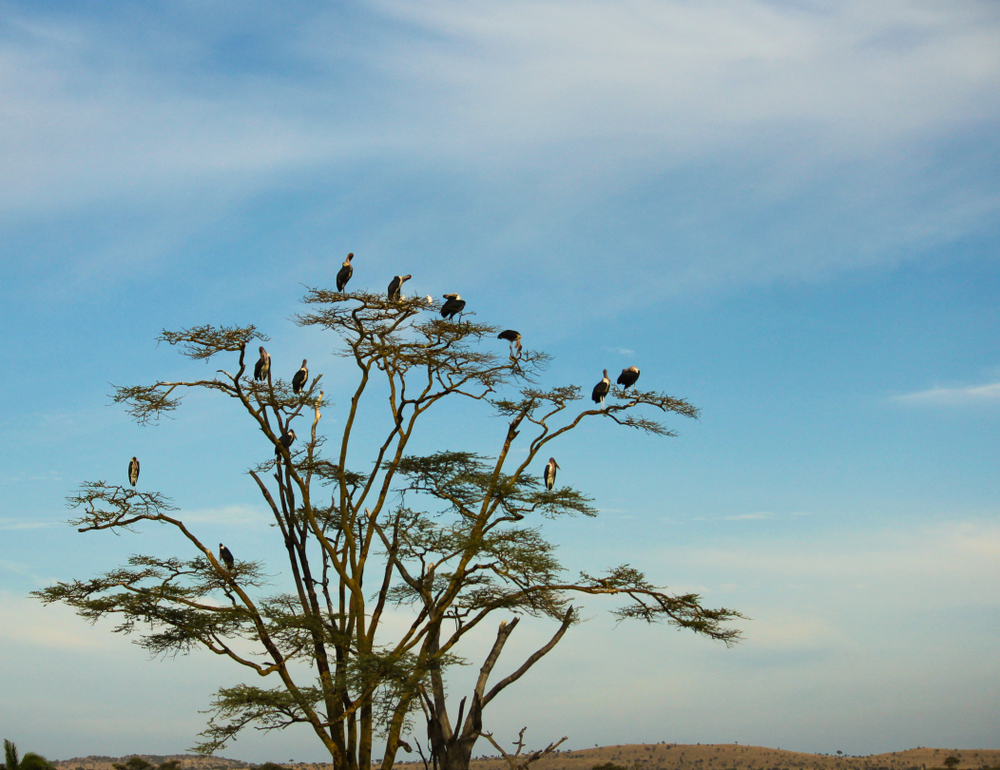About
The Marabou Stork, scientifically known as Leptoptilos crumeniferus, is a large bird species belonging to the Animal Kingdom’s phylum Chordata and class Aves. It is a member of the Ciconiidae family, which also includes other stork species such as the white stork and saddle-billed stork. Marabou storks are native to sub-Saharan Africa, inhabiting a range of habitats from savannas and grasslands to urban areas and garbage dumps.
These distinctive birds are easily recognized by their massive size, with adults typically standing over five feet tall and having a wingspan of up to ten feet. They have a bald head and neck, which are wrinkled and covered in dark gray skin, and a long, slender bill adapted for scavenging. The Marabou stork has a predominantly white body with black flight feathers and a fluffy white tail.
Marabou storks are opportunistic feeders, scavenging for carrion, garbage, and scraps at human settlements, but they also hunt for small animals such as rodents, insects, and fish. They are often seen congregating in large groups near rivers, lakes, or rubbish dumps, where food is plentiful. Despite their somewhat ungainly appearance, marabou storks are powerful fliers, capable of covering long distances in search of food and suitable nesting sites.
Conservation Concerns
While marabou storks are currently listed as least concern on the IUCN Red List, they face various conservation challenges, primarily related to habitat loss, pollution, and hunting. Wetland degradation, deforestation, and urbanization threaten their natural habitats, reducing available foraging areas and nesting sites.
Marabou storks are also affected by pollution, particularly in urban areas where they scavenge for food in garbage dumps and landfill sites. Ingestion of plastic and other pollutants can have detrimental effects on their health and reproductive success. Additionally, they are sometimes hunted or persecuted due to superstitions or conflicts with humans.
Physical Characteristics
The Marabou Stork (Leptoptilos crumenifer) is a large wading bird native to Africa, known for its distinctive appearance and significant size. It belongs to the stork family, Ciconiidae, and is often found in savannas, wetlands, and other aquatic environments. The Marabou Stork plays an important role in its ecosystem as a scavenger, helping to clean up carrion and waste.
Size
- Body Length: Marabou Storks typically measure about 4.3 to 5 feet (1.3 to 1.5 meters) in height.
- Wingspan: They have an impressive wingspan ranging from 7.2 to 9.2 feet (2.2 to 2.8 meters), making them one of the birds with the largest wingspan in their habitat.
- Weight: These birds weigh between 11 to 20 pounds (5 to 9 kilograms), with some large individuals possibly exceeding this range.
Physical Characteristics
- Head and Neck: The head and upper neck of the Marabou Stork are nearly bald, with sparse, wispy feathers. This baldness is an adaptation for hygiene, preventing blood and other substances from adhering to the skin while the bird feeds on carrion. The neck is long and thin, supporting its large bill.
- Bill: They have a large, pointed bill that is powerful and well-suited for tearing flesh, reflecting their scavenging diet. The bill is pinkish-white and can measure up to 13.8 inches (35 centimeters) in length.
- Feathers and Body: The body feathers are primarily white, while the wings and tail are dark grey or black. An inflatable gular sac hangs from the neck, which is pinkish in color and can be inflated to assert dominance or attract a mate.
- Legs and Feet: Marabou Storks have long, skinny, grey legs and large feet, which are well-adapted for walking through shallow waters or across land in search of food.
- Flight: Despite their large size and somewhat ungainly appearance on the ground, Marabou Storks are graceful in flight. They utilize thermal currents to soar and glide, conserving energy during long flights.
The Marabou Stork’s appearance is often perceived as unattractive, especially because of its bald head and neck, and the dangling gular sac. However, these features are practical adaptations to its scavenging lifestyle. The bird’s large size and wingspan, combined with its role in controlling pest populations and cleaning up carcasses, make it an important species in its native habitats across Africa.
Reproduction
Marabou storks, known for their distinctive appearance and scavenging behavior, have a unique reproductive cycle shaped by their habitat and ecological niche. Here’s an overview:
Breeding Season: Marabou storks typically breed during the dry season, which varies depending on their range. Breeding may occur during periods of food abundance, such as when water levels are low and prey is concentrated.
Courtship and Pair Formation: During the breeding season, marabou storks engage in elaborate courtship displays to attract mates and establish pair bonds. These displays include bill clattering, ritualized movements, and vocalizations.
Nesting and Egg-Laying: Once pair bonds are established, marabou storks build large, sturdy nests in tall trees, cliffs, or man-made structures. Both male and female storks contribute to nest construction using sticks, branches, and other materials. After nest completion, the female lays a clutch of one to three eggs, with two eggs being most common.
Incubation: Both parents take turns incubating the eggs, which lasts around 30 to 35 days. During this period, the parents carefully regulate the temperature of the eggs and protect them from predators and environmental threats.
Hatching and Chick Rearing: Upon hatching, the chicks are initially helpless and rely entirely on their parents for warmth and food. Both parents participate in feeding the chicks regurgitated food, typically consisting of small fish, insects, and other prey items. The chicks grow rapidly, reaching adult size within a few months.
Fledging and Independence: Marabou stork chicks fledge and leave the nest at around 90 to 100 days of age. After fledging, they continue to receive parental care and guidance while learning essential skills such as foraging and social behavior. Eventually, they become independent and join the adult population.
Social Dynamics and Group Behavior: Marabou storks are social birds that often breed and nest in colonies, sometimes alongside other species of waterbirds. Breeding colonies provide safety in numbers, with adults collectively defending nests and chicks from predators.
Environmental Influences: The reproductive cycle of marabou storks is influenced by environmental factors such as rainfall patterns, food availability, and habitat quality. Human activities, including habitat destruction and pollution, can also impact breeding success and population dynamics.
Understanding the reproductive cycle of marabou storks is crucial for conservation efforts aimed at protecting their breeding habitats and ensuring the long-term viability of their populations. By conserving key breeding sites and minimizing human disturbances, conservationists can help safeguard these unique birds for future generations.
Lifespan
The Marabou Stork, with its distinctive bald head, massive size, and scavenging behavior, is a large wading bird found in sub-Saharan Africa. Known for its opportunistic feeding habits, these storks play a vital role in ecosystems by consuming carrion and maintaining ecological balance. Lifespan variations exist between wild and captive Marabou Storks due to differences in environmental conditions, predation risks, and human management practices.
Lifespan in the Wild: In their natural habitat, Marabou Storks have an average lifespan of approximately 25 to 30 years. However, individual lifespans can vary based on factors such as food availability, competition with other scavengers, predation, disease prevalence, and environmental conditions. Despite their resilience and adaptability, wild Marabou Storks face various threats that can impact their longevity and survival.
Lifespan in Captivity: Marabou Storks in captivity often live longer than their counterparts in the wild due to factors such as consistent food availability, protection from predators, veterinary care, and reduced exposure to environmental hazards. In well-managed zoos, wildlife sanctuaries, and captive breeding programs, Marabou Storks can live up to 40 years or more, provided they receive proper care and enrichment to mimic their natural behaviors.
Threats to the Marabou Stork:
- Habitat Loss and Degradation: Deforestation, wetland drainage, urbanization, and agricultural expansion threaten the Marabou Stork’s habitat, reducing available foraging and nesting sites. Habitat loss also disrupts ecosystem functions and food chains, affecting the stork’s prey availability and overall survival.
- Human-Wildlife Conflict: Marabou Storks often come into conflict with humans, especially in urban areas where they scavenge for food in garbage dumps, landfills, and open-air markets. Negative interactions with humans, including persecution, poisoning, and habitat disturbance, pose significant threats to the stork’s survival.
- Pollution: Pollution of waterways and terrestrial habitats with industrial chemicals, agricultural runoff, plastic waste, and other pollutants adversely affects Marabou Storks and their prey. Ingestion of contaminated food, entanglement in debris, and exposure to toxins can lead to health problems, reproductive issues, and population declines.
- Hunting and Poaching: Despite legal protections in many countries, Marabou Storks are hunted for their feathers, bones, and other body parts used in traditional medicine, rituals, and crafts. Illegal hunting and poaching for the wildlife trade contribute to population declines and threaten the species’ survival.
- Electrocution and Collision: Marabou Storks are vulnerable to electrocution and collision with power lines, wind turbines, and other infrastructure developments. Collisions with vehicles, fences, and buildings also pose risks, leading to injuries, fatalities, and population fragmentation.
- Climate Change: Climate change alters weather patterns, precipitation regimes, and habitat suitability, impacting the distribution, abundance, and behavior of Marabou Storks and their prey. Changes in temperature and rainfall patterns can disrupt breeding cycles, nesting success, and food availability, exacerbating existing threats to the species.
Conservation efforts aimed at protecting Marabou Storks include habitat preservation, wetland conservation, pollution control measures, community-based education and outreach, law enforcement against illegal hunting and trade, and research to monitor population trends and address emerging threats. Collaboration among governments, conservation organizations, local communities, and stakeholders is essential for ensuring the long-term survival of Marabou Storks and their habitats.
Eating Habits
The Marabou Stork (Leptoptilos crumeniferus) is a large wading bird found in sub-Saharan Africa. Known for its distinctive appearance and scavenging behavior, the Marabou Stork has unique eating habits that contribute to its ecological niche in its habitat.
Diet: Marabou Storks are opportunistic feeders with a varied diet. They primarily consume carrion, including the remains of dead animals, which they scavenge from various sources. Additionally, they also feed on small vertebrates like fish, frogs, rodents, and reptiles. In some cases, they may catch and eat live prey such as insects or small birds.
Scavenging Behavior: The Marabou Stork is often found near water bodies, garbage dumps, or areas with high concentrations of animals, where it can scavenge for food. It relies heavily on its keen eyesight and sense of smell to locate carcasses or other food sources. The stork uses its long, sharp beak to tear into carcasses and extract flesh.
Feeding Strategies: Marabou Storks are known to congregate in large numbers around carcasses, particularly during periods of drought or when large herbivores like wildebeests migrate. They are often seen alongside other scavengers such as vultures and hyenas, competing for access to the remains of dead animals.
Role in Ecosystem: As scavengers, Marabou Storks play an essential role in their ecosystem by helping to clean up carcasses and prevent the spread of disease. By consuming carrion, they help recycle nutrients back into the environment and reduce the potential for disease transmission from decaying animals.
Adaptations for Feeding: The Marabou Stork has several physical adaptations that aid in its feeding habits. Its bald head and neck prevent feathers from becoming soiled with blood and other fluids while feeding on carrion. Additionally, its long legs and large wingspan allow it to cover long distances in search of food and to access hard-to-reach carcasses.
Conservation Concerns: While the Marabou Stork is currently listed as a species of least concern by the IUCN, habitat loss, pollution, and hunting pose threats to its populations in certain regions. Efforts to conserve wetland habitats and minimize human-wildlife conflict are crucial for the continued survival of this unique bird species.
Uniqueness
The Marabou Stork (Leptoptilos crumeniferus) is a large and distinctive bird found in sub-Saharan Africa. Known for its unusual appearance and scavenging habits, the Marabou Stork possesses several unique characteristics:
Large Size: The Marabou Stork is one of the largest flying birds in the world, with a wingspan that can reach up to 3.2 meters (10.5 feet) and a height of over 1.5 meters (5 feet). Despite their impressive size, they are relatively lightweight, with adults typically weighing between 4 to 9 kilograms (9 to 20 pounds).
Bald Head and Neck: One of the most striking features of the Marabou Stork is its bald head and neck, which lack feathers and are covered in wrinkled, pinkish skin. This adaptation is thought to help prevent feathers from becoming soiled while feeding on carrion and also aids in regulating body temperature.
Scavenging Behavior: Marabou Storks are primarily scavengers, feeding on a wide variety of carrion, including fish, mammals, birds, and even human refuse. They are often found near water bodies, garbage dumps, and slaughterhouses, where they scavenge for food.
Unusual Feeding Methods: When feeding on carrion, Marabou Storks employ several unique feeding behaviors. They use their long, sharp beaks to tear apart carcasses and consume both soft tissue and bones. They may also wade into shallow water to catch fish or snatch prey from other birds.
Colonial Nesting: Marabou Storks are colonial nesters, often breeding in large, noisy colonies alongside other waterbirds such as herons and ibises. They build large, untidy nests made of sticks and branches in trees or on cliffs, where they raise their young.
Vocalizations: While not particularly vocal, Marabou Storks produce a variety of guttural croaks and grunts, especially during the breeding season. These vocalizations are thought to play a role in communication within the colony and during courtship displays.
Longevity: Marabou Storks have relatively long lifespans for birds, with individuals capable of living up to 25 to 30 years in the wild.
Cultural Significance: Marabou Storks have cultural significance in many African societies and are sometimes associated with death and the afterlife due to their scavenging habits and association with carrion. In some cultures, they are considered symbols of purification and protection.
Despite their somewhat unappealing appearance and scavenging lifestyle, Marabou Storks play an important ecological role as scavengers, helping to clean up carrion and prevent the spread of disease. Their unique adaptations and behaviors make them a fascinating and integral part of African ecosystems.
Related Family Species
Sources
- Alden, Peter et al, National Audubon Society Field Guide to African Wildlife, New York, NY.
- Burnie, David & Wilson, Don, Animal, Smithsonian Institute, Washington DC.
- Hickman et al, Integrated Principle of Zoology, McGraw Hill, Boston.
- Nolting, Mark, Africa’s Top Wildlife Countries, Global Travel Publishers, Inc., Ft. Laurderdale, FL.





































































